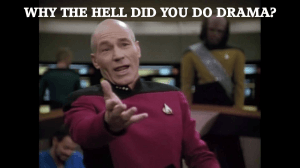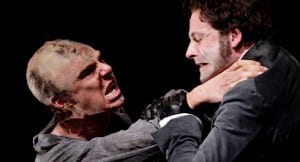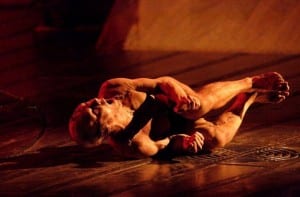The following post contains an in-depth breakdown of the final performance/working presentation.
Bellow follows the script for my working performance/presentation.
A PERFORMANCE ON GHOSTING:
A PERFORMANCE ON GHOSTING:
THE FUN VERSION…
Written by
Alexander Marshall, Kyle Higgins, and Lauren Watson.
Upon entering the space, the audience is subjected to a spectacle of seeing the performance area dominated with layer upon layer of cardboard placards each bearing a different word or line from William Shakespeare’s speech: The Seven Ages of Man. These placards are seemingly placed at random and at this point have no relevance. Cardboard placards: All, The, Worlds, A, Stage (…) (Shakespeare, 1559, .II.IV).
LAUREN and KYLE script in hand is ghosting his own rehearsal. The two actors present on stage are walking aimlessly around the space seemingly looking at the placement of the placards on the ground. ALEX enters late. Several looks are exchanged in disagreement with ALEX’S late arrival. LAUREN and KYLE take center stage and reach into their pocket’s and, pull out small flickering electric candles, ALEX worryingly looks around for his candle and instead adopts a nearby coffee cup in a mad panic.
Darkness.
LAUREN.
When you think of ghosting, what do you imagine?
Images of ghosts etc. Someone whistles/mumbles or sings the Ghost Buster’s theme song.
You’re probably thinking of actual ghosts, bed-sheets, and poltergeists and the occasional jump scares.
KYLE.
But you’re wrong!
ALEX picks up a bed sheet with a piece of cardboard.
Beat. Someone directs an evil glare at ALEX.
LAUREN.
Put it down.
ALEX throws down the cardboard.
KYLE.
There’ll be none of that here.
ALEX.
Oh yes, there will.
KYLE.
Oh no, there won’t.
LAUREN.
If I was to ask you to think of, let’s say for example… James Bond, popular guy, well known, who are you first drawn to?
Have the names of characters on cardboard after they are spoken they are thrown away.
LAUREN:
Daniel Craig?
Throws cardboard.
KYLE.
Sean Connery?
Throws cardboard.
ALEX.
Peirce Brosnon?
Throws cardboard.
KYLE.
Nobody every mentions Timothy Dolton…
ALEX.
– who was really good
LAUREN.
Or that other one?
ALEX.
Lasenbey?
KYLE.
What about Jane Austin’s Pride and Prejudice … Darcy?
LAUREN.
…Mr Darcy to you.
Ask the audience.
ALEX.
Colin Firth, or the other guy?
KYLE.
This is a form of ghosting, you have already been influenced by your cultural and social past. These have made you create these assumptions about these players…
LAUREN.
-or actors
KYLE.
-and link them to these characters, without you even knowing.
ALEX
-it’s like you’re ghosting yourself (making ghost noise).Oooo, oooo…
LAUREN.
This isn’t exclusively linked to characters; ghosting can also be seen in all aspects of performance ranging from set…
KYLE.
lighting
Snap to three spots, then back to wash.
LAUREN.
sound-
ALEX.
-and costume.
Pull down Alex’s trousers to reveal yellow tights.
ALEX.
-and even the physical/stage.
KYLE.
Christopher Booker, states in his text, that there are only seven basic plots, and therefore seven ages of man.
Rags to Riches,
The Quest,
Voyage and Return,
Comedy, Tragedy,
Rebirth,
Over Coming the Monster.
LAUREN.
This means all performances ghost other stories, with the notion that “this is a story that has been told before”.
ALEX states examples of these plots or devices.
Video, begins to play of “All The Worlds A Stage” compilation.
Compilation video used in the performance/presentation. Video made by Kyle Higgins.
Higgins, K. (2017) All The World’s A Stage: Compilation video. 16 January. [accsessed 16 january].
KYLE.
Here you can see one of Shakespeare’s most popular speeches being performed by numerous actors. Each one different but ghosting the other.
ALEX picks up DAGGER SIGN. Begins to reenact speech.
LAUREN:
Wrong speech!
ALEX throws DAGGER SIGN
ALEX.
Some actors will be more prominent than others, this is because you will know them other popular cultures.
For example…
ALEX states examples of these characters.
LAUREN.
Ghosting cannot be escaped in regards to performance. When you go the
When you go the theatre, see a film, read a book, you will inevitably either think of the last similar thing you saw or the one which was merely most memorable.
KYLE.
It is not hard to see why it is easily accepted when theatrologist Marvin Carlson argues that theatre is “among the most haunted of human cultural structures” (Carlson 2003, p. 2); costumes are re-used, the space itself is re-created for each new performance, actors are recycled and language re-worked.
ALEX.
Such as Shakespearian character tropes – the fool,
the lovers,
KYLE beckons LAUREN over to his side of the stage.
the villain. (repeats).
Essentially no character created is going to be new, and will…
KYLE and LAUREN begin to attempt to make love behind some cardboard.
generally, fall into one of the eight archetypes.
KYLE.
Hero,
Mentor,
Ally,
Herald,
Trickster,
Shapeshifter,
Guardian and Shadow.
LAUREN and ALEX run across the stage looking for the corresponding placards.
LAUREN.
Although this idea of theatre being haunted sounds potentially exciting, it can actually be fairly limiting
ALEX and ghost pulled from pocket
LAUREN.
-as previously discussed there are no white sheets here.
ALEX.
If you saw (or are going to see) the latest production of Harold Pinter’s No Man’s Land by the National Theatre with Ian Mckellan and Patrick Stewart, you may be confused to find there are no mutants in it and Stewart can in fact walk.
LAUREN.
-And he’s not from the Enterprise
KYLE.
-and Ian Mckellan will indeed let you pass!
Video or memes of YOU SHALL NOT PASS and Steward with head in hands.
LAUREN.
-On a serious note, though, you will always picture a previous actor in their most established (or most memorable role) This is arguably a subconscious reaction as, “the performance of past memories are recalled”.
KYLE.
-This means that you are never fully present for the liveness of the theatre as your mind wanders into past recollections of where you have seen those actors, where you heard that song,
‘Do You Hear The People Sing’ quietly plays.
ALEX.
-what you last saw in that venue,
what you took away from your last experience.
KYLE.
Liveness is…
Definition is shown on unfolding cardboard.
ALEX.
-the performance, or general life event, being shown and performed in the here and now. Like this.
LAUREN.
And this.
KYLE.
And this.
ALEX.
And this.
ALL.
Live!
ALEX.
Not shown mediated through a camera, supposedly live streamed from London.
LAUREN.
Thank you NT Live…
KYLE.
-The act of performance and the reality of theatre is ghosted by itself – it’s ephemeral, (makes deliberate mistake in pronouncing word)
made to be seen and experienced in the moment. Disappearing before our eyes, as each speech ends and the next one begins –
LAUREN.
-alternatively, the practice of Ghosting can be lucrative within the theatre in terms of marketing upcoming events. If a
If a theatre were, to say, employ Benedict Cumberbatch, for the role of, oh I don’t know, Hamlet. He hasn’t done that yet, has he?
ALEX.
He may have done a small fringe version or something He may have done a small fringe version or something
Images of Benedict as Hamlet on stage
KYLE.
– fair enough. Well if this fictional production should happen, people would undoubtedly rush to buy tickets to see it simply because of it being…
ALEX.
-or seeming to the audience.
LAUREN.
-to be Sherlock
ALEX.
-or Khannnnnn!
KYLE.
– or Smaug
LAUREN.
– or even the enigma that is Alan Turing.
ALEX.
– on stage as Hamlet. Arguably, people aren’t coming to see a Shakespearean masterpiece, they’re coming to see someone they “know” and can relate to on stage.
LAUREN.
Is this them ‘selling out’, getting a ‘celebrity’ to fill their seats?
KYLE gets agitated
KYLE.
It’s not them selling out!
ALEX.
Two opinions, both alike in dignity, in fair Lincoln, where we lay our scene…
LAUREN.
With a pantomime starring the once fair Kerry Katona
KYLE.
-once fair?
ALEX.
-it fits the style, shut up!
Pantomimes battle year after year for better audience numbers for which the best way to guarantee this is by getting the biggest star. Let’s make a poll.
Who would you rather see, Biggins or Hasselhoff as the dame?
Grab a cardboard with their names/faces and ask for hands. Discard. KYLE does the cardboard
LAUREN.
The chuckle brothers or cannon and ball as Tweedle dumb and tweedled dee?
As above. ALEX does cardboard.
KYLE.
Lilly Savage or Dame Edna as the fairy godmother?
As above. LAUREN does cardboard
LAUREN.
See, we all have a preference, certain ‘ghosted’ characters or actors will draw in better crowds
ALEX.
-or a better class of crowd.
KYLE.
I’m confused now, are we on about positives or negatives?
LAUREN.
-Well, “Every performance, if it is intelligible as such, embeds features of previous performances: gender conventions, racial histories, […] political and cultural pressures that are consciously and unconsciously acknowledged”.
ALEX.
Making people aware of such histories can’t be a bad thing, surely?
KYLE.
Speaking of ‘bad’ things…
ALEX.
Ghosting, is not only a product of theatre.
It can be seen more recently as evidenced by the current political president…
KYLE.
Elect-
LAUREN picks up cardboard with a cat (pussy) and ALEX and KYLE grab it
ALEX.
The Don Man, and many times he has mentioned that he is a little bit, partially, well fairly, ok very, overtly ridiculously, rich.
KYLE.
(impersonating Trump. ) Rich, rich, rich, he’s very rich
During the above KYLE and ALEX and LAUREN throw pieces of cardboard which they have miraculously found in their pockets which say money/£/$…
ALEX.
By the way, he has some spare cash.
LAUREN gets on her knees, with a sign saying ‘looking good’
KYLE.
This is of course just a heightened example to show it’s not just in theatre that ghosting occurs, it occurs within ‘characters’ that really do-
LAUREN.
unfortunately-
KYLE.
exist.
ALEX.
As there is no denying that Trump is a created theatrical persona.
The three hand gestures.
LAUREN.
So much so that people are creating artwork and performances about him.
Show the art images from Facebook and Alec Baldwin’s impressions (SNL), It’s Complicated Alec and naked Donald Trump.
Compilation image of “ghosted” Donald Trump performances used in performance/presentation.
ALEX.
Now, although we may have been talking at you about various celebrities and very well-known characters, we have been working something else into this presentation. As you may have noticed, Shakespeare has been brought up maybe once or twice/
Now, although we may have been talking at you about various celebrities and very well-known characters, we have been working something else into this presentation. As you may have noticed, Shakespeare has been brought up maybe once or twice/
LAUREN.
-or every other sentence/
KYLE.
from Hamlet, the slight quote of Romeo and Juliet, to Benedict.
ALEX.
Be honest with yourself, if we featured classical actors who are well renowned, respected and considered to be the leaders of their profession, but have fallen into obscurity in current society would you have felt quite as engaged with this presentation as you have been with us featuring Cumberbatch, Craig, and all the many others we don’t have time to re-name. You were interested due to what you know them from, you were interested because of ghosting.
KYLE.
-Seeing as ghosting happens across the world, in every situation, we wanted to ghost ourselves in this performance, after all,
all the world is a stage…
LAUREN.
But, did you notice this?
“All the world’s a stage, all the men, and women merely players…”
Cut to screen, where our script creates the speech.
Script with words and Shakespeare link.
Edit: Below follows a working transcript of the performance/presentation script that is ghosting William Shakespeare’s text. We tried to use the following words as many times as possible so that when ghosting, we were not drawing explicit attention to the famous line and, the spectators would only perceive this on a cognitive, meta-theatrical and subconscious level.
A PERFORMANCE ON GHOSTING: THE FUN VERSION.
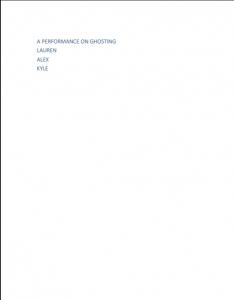


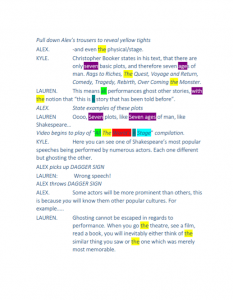
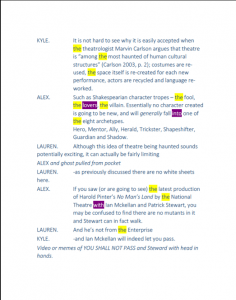
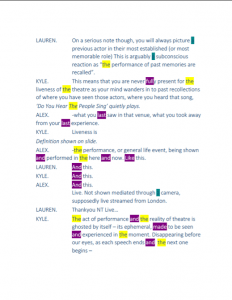
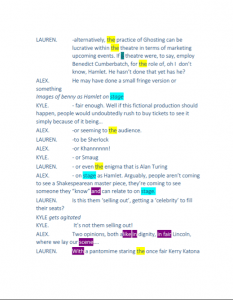
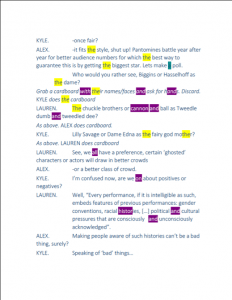
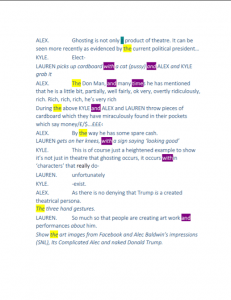
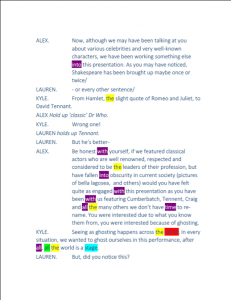

(Higgins, 2017).
KYLE.
In regards to theatre, drama, and performance, we really do believe ghosting, is… the… current issue
ALEX.
Thank you for your time.
KYLE.
If you would like to exit stage-left…
LAUREN.
The bear will see you out.
Fin.
My Observations.
The overall aim of this presentation/performance was to give a tongue and cheek perspective of ghosting that explicitly aimed while attempting to be scholarly, mock the overall concept of ghosting in performance. This attempt at mockery is what led the visual and ascetical roughness to look like it had been thrown together when in reality it has taken weeks of planning and strategy in order to navigate of what could almost be described as a minefield of cardboard (no pun intended). This visual style inspired by Forced Entertainment.
This visual style inspired by Forced Entertainment’s, 12am: Awake & Looking Down (1993) allowed us to create something almost from nothing and in many ways, ghost the very act of performance and language itself. Our aim was to have a visual mouthpiece that would seem to overwhelm the spectator upon entering the space, with the floor covered in all manner or words and references to our play-text. With the added benefit of technology we were able to create yet again, a rough ascetical powerpoint that mocked the very performance we were about to re-tell, as in essence, we were ghosting our own kayos-ridden rehearsal process. Nothing to seemed to go quite to plan and, this feeling of theatre ghosting itself in all areas is what drove our performance/presentation. The harsh reality of theatre and performance is sometimes things do not go to plan and this very concept of rebirth and retelling of a narrative is something we wanted to echo. Allowing ourselves the freedom to link our performance/presentation to popular media also, allowed us the luxury of further rebirthing and retelling how ghosting is an ever ongoing issue in culture and society. This act of ghosting, also led to the discussion that one person in our performance/presentation should carry and exploit the use of a physical script in performance e.g ghosting the very text and performance that was unfolding from a previous encounter or experience.
Allowing ourselves the freedom to link our performance/presentation to popular media also, allowed us the luxury of further rebirthing and retelling how ghosting is an ever ongoing issue in culture and society. This act of ghosting, also led to the discussion that one person in our performance/presentation should carry and exploit the use of a physical script in performance e.g ghosting the very text and performance that was unfolding from a previous encounter or experience.
This concept is similar to seeing a live performance that is live-cast as you will ghost a previous performance the actor or actors are portraying in that space.
Overall, I thought we delivered as stated above, a tongue and cheek performance/presentation that while being a mockery of the subject matter that is ghosting. This performance/presentation highlighted and drew attention to important issues of its importance withing both society and culture. Ghosting remains as it always has, an unspoken cognitive, phrenological, mental process that maintains a constant presence in any given space regardless of context or its subject matter explored through the medium of performance. In essence, we wanted to draw attention to Marvin Carlson’s teachings and theories on the subject that is the concept theoretical concepts of ghosting.
